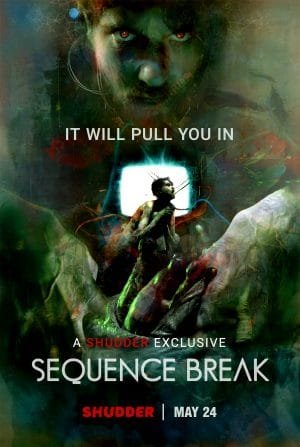 It’s a curious twist of fate/scheduling that writer-director Graham Skipper’s arcade game-themed horror should land on streaming platform Shudder in the same week that David Cronenberg’s eXistenZ gets its UK Blu-ray release. The Canadian body horror pioneer’s 1999 film would seem a likely influence on Sequence Break, given the gaming angle and the emphasis on people merging with technology in a bizarre and explicitly sexual manner. Another film with which Sequence Break automatically draws comparisons is 2016’s Beyond The Gates: not only did this star both Skipper and leading man Chase Williamson, it also centred on an antediluvian place of business (in Beyond The Gates a mom & pop VHS rental store, here an arcade game restoration workshop) in which playing one particular game has very real consequences which seem to go against all laws of science.
It’s a curious twist of fate/scheduling that writer-director Graham Skipper’s arcade game-themed horror should land on streaming platform Shudder in the same week that David Cronenberg’s eXistenZ gets its UK Blu-ray release. The Canadian body horror pioneer’s 1999 film would seem a likely influence on Sequence Break, given the gaming angle and the emphasis on people merging with technology in a bizarre and explicitly sexual manner. Another film with which Sequence Break automatically draws comparisons is 2016’s Beyond The Gates: not only did this star both Skipper and leading man Chase Williamson, it also centred on an antediluvian place of business (in Beyond The Gates a mom & pop VHS rental store, here an arcade game restoration workshop) in which playing one particular game has very real consequences which seem to go against all laws of science.
Much as Beyond The Gates was an entertaining but ultimately somewhat lightweight horror that didn’t quite squeeze the full potential out of its premise, Sequence Break is also fun while it lasts, but not quite packing as much punch as we might like. Even so, it’s plenty enjoyable enough to warrant a viewing from anyone with a taste for body horror and/or arcade games.

Oz (Williamson) is one of those lovable loser types. A dedicated old-school video game enthusiast, he works in the workshop run by Jerry (Lyle Kanouse) fixing up vintage coin-op machines for interested buyers. But then, on a bit of a good-news bad-news day, Jerry tells Oz that business is so bad, he’s being forced to close up shop. However, that same day they’re visited by Tess (Fabianne Therese). She doesn’t buy a game, but she does take a shine to Oz, and soon thereafter romance is blossoming. At the same time, though, Oz is unwittingly entering into a perhaps even more intimate relationship of a considerably less healthy variety. On finding a circuit board mysteriously delivered to the shop in an unmarked envelope, Oz hooks it up to a vacant cabinet and discovers a game he’s never seen before (looks a bit like a cross between Tempest and Asteroids). As he begins to play, Oz finds the game somehow digging into his mind, blurring the line between dream and reality; and the deeper the bond gets, the more dangerous it becomes.
Fans of the contemporary US indie horror scene should immediately find plenty to appreciate in Sequence Break. On top of the Beyond The Gates connection, it’s also a John Dies At The End reunion, with Williamson and Therese once again playing new lovers. Both actors have stuck with the genre since Don Coscarelli’s 2012 David Wong adaptation, doing some nice work along way, and the chemistry between the two is one of Sequence Break’s greatest strengths. The film boasts a grand total of five characters: on top of Oz, Tess and Jerry, we have Audrey Wasilewski as a bartender (Bechdel Test advocates might not find her brief scenes with Therese agreeable), and John Dinan as a mysterious vagrant who knows things about the otherworldly video game. As such, the focus really is on the two leads for the bulk of the film, and if we didn’t grow to care about them or their relationship, it would be a pretty thankless venture. Happily, this is not the case, even if Tess comes dangerously close to Manic Pixie Dreamgirl status at times.
Hand-in-hand with effectively exploring a burgeoning romance, Sequence Break presents a portrait of struggling young adults with big dreams they have yet to realise – Oz as a games designer, Tess as a writer – which is easy to relate to. Questions might be asked, however, as to how well these elements balance out with what the audience is really paying to see: body horror. Given the arcade game theme, we might be forgiven for expecting the film to be drowning in 80s retro affectations in a Stranger Things/Turbo Kid style, but happily this isn’t the case, even if Skipper has opted for a very 80s colour scheme with lots of harsh red and green lighting, and abundant use of gooey practical FX work rather than CGI. The thing is, while there is a very Cronenbergian feel to these icky surrealist sequences, I’m not sure how well they gel with the otherwise more grounded storytelling. It doesn’t help that the final resolution of it all feels a bit insubstantial and sappy.
All this having been said, Sequence Break remains an entertaining piece of work, and a laudable addition to the body of work from all involved. I certainly hope it isn’t the last we’ll see from Skipper as writer-director.
Sequence Break is available exclusive to Shudder from 24th May.
